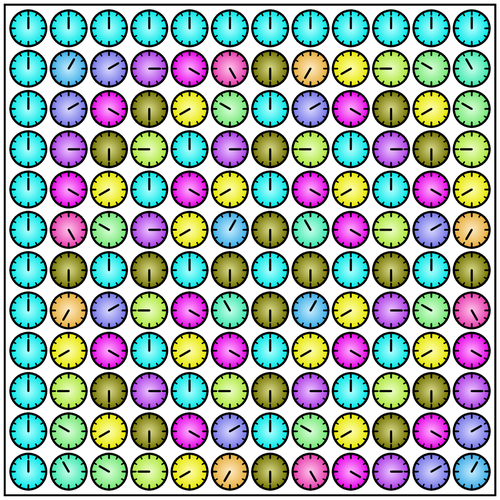This example shows the products i times j for i and j from 0 to 11 by using arithmetic modulo 12, i.e., the so called arithmetic of the clock.
The results of the products are represented both by the color of the clock and by the hand.

Edit and compile if you like:
% Arithmetic of the clock
% Author: Juan Luis Varona
% http://www.unirioja.es/cu/jvarona/
\documentclass{article}
\usepackage{amsmath}
\usepackage{tikz}
\usepackage[active,tightpage]{preview}
\PreviewMacro[{{}}]{\fbox}
\setlength\PreviewBorder{3pt}
% Colors:
\definecolor{clock0}{cmyk}{1,0,0,0} % cyan
\definecolor{clock1}{cmyk}{0.75,0.25,0,0}
\definecolor{clock2}{cmyk}{0.5,0.5,0,0}
\definecolor{clock3}{cmyk}{0.25,0.75,0,0}
\definecolor{clock4}{cmyk}{0,1,0,0} % magenta
\definecolor{clock5}{cmyk}{0,0.75,0.25,0}
\definecolor{clock6}{cmyk}{0,0.5,0.5,0}
\definecolor{clock7}{cmyk}{0,0.25,0.75,0}
\definecolor{clock8}{cmyk}{0,0,1,0} % yellow
\definecolor{clock9}{cmyk}{0.25,0,0.75,0}
\definecolor{clock10}{cmyk}{0.5,0,0.5,0}
\definecolor{clock11}{cmyk}{0.75,0,0.25,0}
\begin{document}
\newcommand{\clock}[4]{%
\begin{scope}[xshift=2.25*#1cm,yshift=2.25*#2cm]
% \filldraw [fill=#3, line width=1.6pt] (0,0) circle (1cm); % simple fill (unused)
% \draw[fill] (0,0) circle (1mm); % border (unused)
\shadedraw [inner color=#3!30!white, outer color=#3!90!black,
line width=1.6pt] (0,0) circle (1cm); % disk with shadow and border
\foreach \angle in {0, 30, ..., 330}
\draw[line width=1pt] (\angle:0.82cm) -- (\angle:1cm);
\foreach \angle in {0,90,180,270}
\draw[line width=1.3pt] (\angle:0.75cm) -- (\angle:1cm);
\draw[line width=1.6pt] (0,0) -- (90-30*#4:0.6cm); % the hand
\end{scope}
}
% Default on latex.ltx: \fboxsep = 3pt \fboxrule = .4pt
\fboxsep = 3pt \fboxrule = 1.5pt
\newcounter{itimesj}
\fbox{%
\begin{tikzpicture}[scale=0.5]
\begin{scope}[line cap=round]
\foreach \i in {0,...,11}
\foreach \j in {0,...,11} {
% We use round by caution, because we are getting real numbers
\pgfmathparse{round(mod(\i*\j,12))}
% \pgfmathresult = 3.0 gives itimesj = 3
\pgfmathsetcounter{itimesj}{\pgfmathresult}
\clock{\i}{-\j}{clock\theitimesj}{\i*\j};
}
\end{scope}
\end{tikzpicture}%
}%
\end{document}
Click to download: arithmetic-of-the-clock.tex • arithmetic-of-the-clock.pdf
Open in Overleaf: arithmetic-of-the-clock.tex


